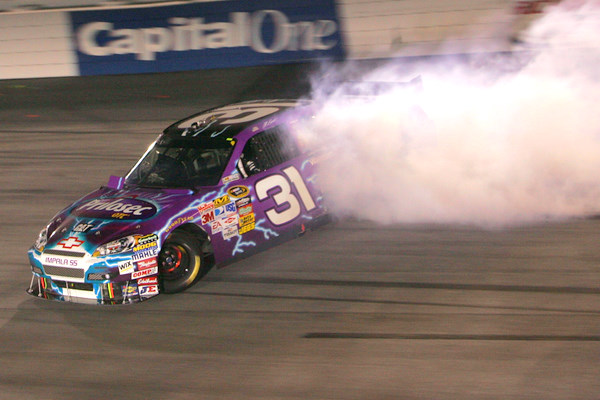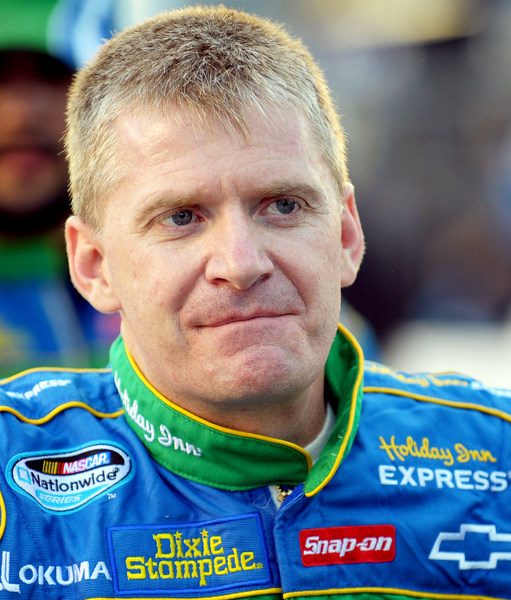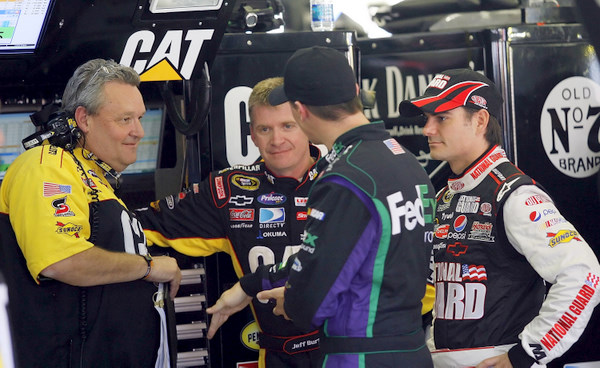Is it time for NASCAR to start cracking down on rough driving? Or maybe hand out bonuses for hard hits....

It wasn't an easy Saturday night at Richmond for Jeff Burton, but he was in the hunt for the win at the end (Photo: Getty Images for NASCAR)
By Mike Mulhern
mikemulhern.net
RICHMOND, Va.
Jeff Burton is saying I told you so – that NASCAR was about to turn the corner.
Indeed, after a slow start to the season, and a lot of complaints about low TV ratings, somewhat short crowds, and less than impressive racing, the sport has suddenly hit its stride, with outstanding races back-to-back at Talladega and Richmond.
Now Darlington, where misfortune can strike in a heartbeat, and that sizzling Ricky Craven-Kurt Busch finish still resonates.
"I told you we were fixing to have three great races in a row -- Phoenix, here and Talladega," Burton was saying after an impressive rally of his own, to third in Saturday night's Richmond 400.
"I think Darlington is going to be another good race.
"It's the stretch of races that we're in. You're going to see great races in Phoenix, and you're going to see great racing here. At Talladega, obviously you're going to see whatever that is…."
At Talladega Burton rallied from three laps down (a battery issue) to make a run at the win….and a punt on then-leader Kyle Busch.
And Burton rallied here Saturday too.
"That's one thing that our team is really good at -- we're very resilient. We never quit. That's kind of our trademark -- we don't have the fastest car every week. Every now and then we might be the fastest car, but we're not normally the fastest car. But we chisel finishes out.
"We find a way to finish sixth and eighth and ninth.
"That's not great…but that's our strength.
"We keep trying to find the speed to put with that. When we do, we'll be pretty dangerous.
"But we're pretty resilient, and we just go fight. I take a lot of pride in trying to make something happen."
And at Talladega, did Burton really drop-kick Busch?
That's what Burton admitted here.
It came is a discussion about the possibility that NASCAR may start cracking down on rough driving at Talladega.
The Talladega 500 was unusually rough and ragged, with drivers brutal on each other.
"Well, listen – we've been talking about this for a long time, and here's the reality of the situation: If you don’t bump-draft you can't run in the front," Burton says.
"If you don't block, you won't run in the front.
"If you just ride around, trying not to touch anybody, trying not to block anybody, you run in the back. End of story.
"The yellow line rule (out of bounds), it's easy to look at last week and say the yellow line rule was bad for that situation. But you forget why the yellow line rule is there.
"If you were racing or watching racing prior to the yellow line rule, you remember why it was there.
"It has prevented way more wrecks than it's ever caused, I can tell you that.
"We used to enter turn three at Daytona five or six-wide, with people on the bottom of the track.
"When there was not a boundary, it created a major problem.
"So what do you do?
"That's the great question.

Jeff Burton has come on strong the last few weeks (Photo: Getty Images for NASCAR)
"Should you do anything?
"If Carl Edwards hadn't have gotten in the fence, I think everything would have been how great the race was.
"The fact he did get in the fencing and people got hurt certainly means we need to look at it.
"But it's no different than it was 10 years ago, 15 years ago.
"The only thing NASCAR can do in my opinion -- they have two options: The first one is make the cars drive so bad that the cars get spread out.
"Let's be clear: the wreck we saw at Talladega on the last lap could have just as easily happened at Michigan. If you're leading the race and you block the guy running second, you might get turned around.
"By the same token, if Brad Keselowski isn't pushing him, they never get to the front. So without contact (bump-drafting), they're not in the front.
"If Carl Edwards doesn't block, he has no chance of winning.
"What do you do?
"So, there are two choices: separate everybody, make the cars drive so bad that everybody gets separated. Now fans are going to hate it. We have given the fans a look at something that they don't want to give back. Rightfully so; it's fun to watch.
"The only other thing you can do is put NASCAR in the position of penalizing you any time you're involved in an incident.
"If you cause a wreck, penalize you.
"They are going to have to judge it.
"That's a terrible thing…because if you're sitting in a race car, you know what happened. If you're watching it, you may not know what happened.
"I spun Kyle Busch out Sunday. I spun him out. If they would have made the call on me and penalize me, I would have deserved it, because it was 100 percent my fault.
"The problem is, don't penalize me if you're not going to penalize everybody for the 50 races before it.
"NASCAR is in a tough spot.
"I don't want NASCAR to have to make the call anytime something happens, but that's what it's coming to.
"It's coming, because it's easy to say 'Well, just don't bump draft.'
"But if it works, I'm going to do it. That's what I get paid to do -- to get 100 percent out of my race car. And if pushing somebody makes my car faster, then I'm going to push them.
"The only way to stop it is if you cause a wreck you have to be penalized.
"The problem I have with it is how do you determine if you caused a wreck or not…and who would you have penalized in the last lap wreck. Who would you have penalized?
"Was it Carl's fault? Was it Keselowski's fault?
"I don't know.
"Do you penalize both of them?
"That's the problem…and I don't know how we fix it.
"It's not an easy fix.
"It's a complicated issue, and at the end of the day they're going to have to make us wish we hadn't of done something that we shouldn't have been doing.
"That's the only way I know to make it better."

Crew chief Scott Miller (L) and Jeff Burton (C) are suddenly scrappy. (Photo: Getty Images for NASCAR)
© 2010-2011 www.mikemulhern.net All rights reserved.
Web site by www.webdesigncarolinas.com







Fix the cars, not the drivers.
NASCAR should punish drivers only in extreme situations. If a driver uses his car as a weapon, he should be punished. If he uses his car to deliberately cause serious damage to another driver's car, he should be punished.
NASCAR should not punish drivers for racin' hard. As Burton says, they're trying to get 100% out of their cars. That's what fans pay to see. That's what fans tune in for. Fans want to see passionate drivers giving all they have.
The problem is that plate racing puts drivers in a situation where they have very little control to make their cars better. They can bump draft and they can block. That's it. Different lines don't matter. Better setups don't matter. The only thing that matters is track position. Therefor drivers have to do everything they can to gain and hold track position.
NASCAR should restore throttle response to the cars at the super speedways. Find a different way to slow the cars: aero packages, smaller tires, smaller engines, whatever. They need to get to a point where a driver has to back out of the throttle in order to negotiate the turns, then get back in the throttle to accelerate down the straights. That's racin'. Holding the throttle wide open and jockeying for position is not.
Respectfully,
+ Leonard
Reply to comment
Handling Is Never Supposed To Get In The Way
Leonard, racing hard and racing dirty are two different things, and a lot of people seem to have them confused.
Preventing wrecks is simple - drivers, hold your lines better.
The "problem" with plate racing is not there. "Different lines don't matter." Yes they do - they allow passing. "Better setups don't matter." They're not supposed to - it's supposed to be driver, not just car.
The cars don't need more throttle response because they have enough of it and it's overrated to start with. There has never been a wreck where throttle response allowed a driver to escape - they either get into it or dodge it. The myth that lack of throttle response has hurt ability to pass is all that - myth. The reality is throttle response has NEVER mattered that much - the cars needed the draft to pull off "slingshot" passing; when the draft went away around 1985 the slingshot died. Passing didn't come back to the superovals until they mandated the restrictor plates and NASCAR began increasing spoiler sizes to get the draft back. On the intermediate ovals the draft wasn't as effective but it WAS strong - "The draft doesn't take effect here (Charlotte) like it does Talladega or Daytona, but it helps, it definately helps here," Donnie Allison noted before the 1977 World 600; the draft was a factor on intermediates until the cars got so aero-clean that displacement of air all but disappeared and what air was displaced began stopping trailing cars instead of pull them forward.
All the "alternatives" to the restrictor plates have failed - they thought they could run the Trucks unrestricted because of aero; the first time they did Geoff Bodine ripped open 100 feet of Daytona fencing and the Trucks got their ram-air houses taken out and smaller carbs, carb spacers, everything short of the plates put in, where their throttle response is long gone. Smaller tires are unsafe and don't slow anything down. Smaller engines failed when NASCAR tested one and when they ran 280 CID V6s in BGN.
Throttle response is NOT, repeat NOT, racing. Racing is open throttle at speeds the tracks can safely handle - meaning they need to come down from where they presently are. Racing is drafting, sidedrafting, pushdrafting - combat, in short. Handling is never supposed to get in the way of passing.
"The problem is, don't
"The problem is, don't penalize me if you're not going to penalize everybody for the 50 races before it."
That's the million dollar quote right there. NASCAR is about as consistant with their in-race calls as the weather. I would like to see some rough-driving penalties handed out when drivers get dumped. I don't want to take away the aggresiveness of the drivers that drive hard, just the intentional spinouts with no penalties and the bump and runs that come at the end of races with no recourse. That stuff is bush league. Include blocking in that chapter of the rulebook if you want, also. The penalties are needed, I just don't trust NASCAR to hand out the penalties to everyone on the track consistantly. I've seen the rough driving penalties work at the regional level (USAR) and at the local short track. Sure it's a judgement call, but there are judgement calls in every other major sport. It's just a matter of them being called consistantly for each team and consistantly throughout the race.
Racing Hard And Racing Dirty
Some people seem to have lost the difference between racing hard and racing dirty. The Winston 500 was far superior to anything at Phoenix or Richmond, and it was not a case of needing to punish anything. Drivers can hold their lines better - they don't need NASCAR to tell them that. The whole pushdrafting argument is stupid - they call it bumpdrafting but it's wrong - it's PUSH-drafting because that is the goal. It is what these drivers are SUPPOSED to do. Obviously nobody remembers Richard Petty blasting Buddy Baker, A.J. Foyt, or Cale Yarborough down the straights on the big tracks, else this would never even be an issue.
The wrecks all happened because drivers did not hold their lines properly. Carl Edwards knew he'd screwed up and paid the price for it; he waited far too long to go for the lead, so when the inevitable counterattack came he had no time to deal with it. This is why laying out back always fails - you have to go for the lead because you won't win if you don't lead and you won't win if you leave yourself no time to get it back.
Before talking about "aggressive driving," we need to understand the difference between racing hard and racing dirty.